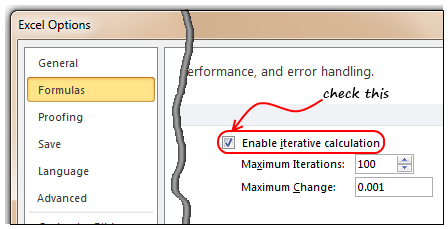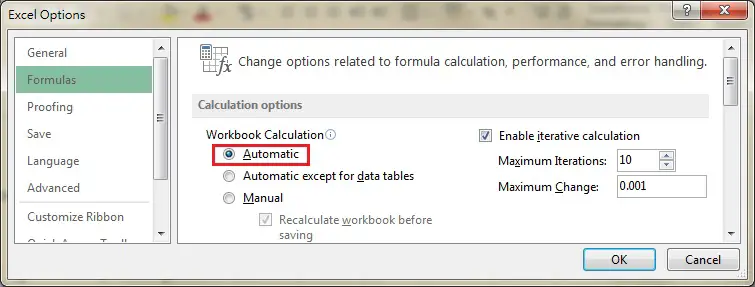- How To Do Calculations In Excel
- See Full List On Ablebits.com
- Basic Excel Formulas
- Enable Manual Iteration On Excel 2011 Full
To enable circular references, turn on Excel’s Iterative Calculation option: Excel 2007 and later: Choose File, Options, Formulas, and then click Enable Iterative Calculations, as shown in Figure 2. Excel 2003 and earlier: Choose File, Properties, Calculation, and then click Iteration. Excel 2011 for Mac: Click on the Excel Menu, choose. To enable the management of iterative calculations, the Formulas tab in the Excel Options dialog box offers two controls: Maximum Iterations This value is the number of iterations after which Excel must stop the calculation if it hasn’t yet converged to a solution. The default value is 100.
-->How To Do Calculations In Excel
See full list on ablebits.com. Since these formulations enable manual calculation, iterative computer efforts are not required. The formulations under consideration can be applicable to symmetric and non-symmetric rigid spread.
Note
Office 365 ProPlus is being renamed to Microsoft 365 Apps for enterprise. For more information about this change, read this blog post.
Summary
In Microsoft Excel, all currently open documents use the same mode of calculation, regardless of the mode in which they were saved.
More Information


To help explain how the mode of calculation is determined, this article refers to the following hypothetical documents:

| File name | Kind of document | Mode that is used to save the file |
|---|---|---|
| Auto1.xlsx | Workbook | Automatic |
| Manual1.xlsx | Workbook | Manual |
| Auto2.xlsx | Workbook | Automatic |
The following statements apply to calculation modes in Excel:
- The first document that is opened uses the calculation mode with which it was last saved. Documents that are opened later use the same mode. For example, if you open Auto1.xlsx and then open Manual1.xlsx, both documents use automatic calculation (the mode used by Auto1.xlsx). If you open Manual1.xlsx and then open Auto1.xlsx, both documents use manual calculation.
- Changing the calculation mode of one open document changes the mode for all open documents. For example, if Auto1.xlsx and Auto2.xlsx are both open, changing the calculation mode of Auto2.xlsx to manual also changes the mode of Auto1.xlsx to manual.
- All sheets that are contained in a workbook use the same mode of calculation. For example, if Auto2.xlsx contains three worksheets, changing the mode of calculation of the first worksheet to manual also changes the mode of calculation to manual in the other two sheets.
- If all other documents are closed and you create a new document, the new document uses the same calculation mode as the previously closed documents. However, if you use a template, the mode of calculation is the mode that is specified in the template.
- If the mode of calculation in a workbook changed and the file is saved, the current mode of calculation is saved. For example, if Auto1.xlsx is opened, Manual1.xlsx is opened, and Manual1.xlsx is immediately saved, the mode of calculation is saved as automatic.
How to control the mode of calculation
All open documents use the same mode of calculation. You must follow special procedures to work with documents that use different calculation modes. For example, if you are working with Auto1.xlsx and you want to open Manual1.xlsx in manual calculation mode, take one of the following actions:
- Set Auto1.xlsx to manual calculation mode before you open Manual1.xlsx.
- Close Auto1.xlsx (and any other open documents) before you open Manual1.xlsx.
There are four modes of calculation that you can select in Excel. They are as follows:
- Automatic
- Automatic except for data tables
- Manual
- Recalculate workbook before saving
| Mode | Time when calculation occurs |
|---|---|
| Automatic | When you make any change to the document. All affected parts of the document are recalculated. |
| Automatic except tables | When you make any change to the document. All affected parts of the document except tables are recalculated. A table is recalculated only when a change is made to it. |
| Manual | When you press F9, click Options on the Tools menu, click the Calculation tab, and then click Calc Sheet. |
| Manual / Recalculate before saving | When you press F9 or click Calc Sheet on the Calculation tab on the Tools/Options menu. Calculation also occurs every time that you save the file if you have the checkbox 'Recalculate workbook before saving' checked under File > Options > Formulas. |
Recalculate the active sheet
See Full List On Ablebits.com
To recalculate only the active sheet, use one of the following methods:
- Press SHIFT+F9.
- Click Calculate Sheet on the Formulas menu in the Calculation group.
Recalculate all open documents
To recalculate all open documents, use one of the following methods:
- Press F9.
- Click Calculate Now on the Formulas menu in the Calculation group.
How to change the mode of calculation in Excel
To change the mode of calculation in Excel, follow these steps:
- Click the Microsoft Office Button, and then click Excel Options.
- On the Formulas tab, select the calculation mode that you want to use.
For Excel reports, you can use a separate sheet per content to output. For example, you can use a separate sheet per area. You can output an Excel file with separate sheets for each content, such as sales amounts in the Kanto area, sales amounts in the Kansai area, and sales amounts in the Kyushu area.

Basic Excel Formulas
The feature for using different content for each sheet is referred to as 'sheet iteration'. This section describes how to set sheet iteration.
Enable Manual Iteration On Excel 2011 Full
Enable sheet iteration
In the Layout Editor screen, click Sheet Iteration on the toolbar.
The Sheet Iteration screen appears. Select the Use Sheet Iteration check box.
Configure the details for iteration
Set the title of each sheet in Sheet Title when using separate sheets.
In Iteration Target Name, specify an item used as the key for separating sheet content. For example, specify an item that contains area values (such as Kanto and Kansai) when using separate sheets for each area, or another item that contains store values (such as Branch A and Sales Office B) when using separate sheets for each store.
In Category, specify a value used for separating sheet content. A full board search is executed with the specified value, and the content filtered based on that value is output for each sheet. This is iterated for each value. For example, if you want to use separate sheets for each area, specify values, such as 'Kanto' and 'Kansai', or if you want to use separate sheets for each year, specify values, such as '2015' and '2016'.
Direct Input
Register a value by entering it directly. You can create a value using the New button.
Item Value
Specify items to separate sheet contents based on their values. Configure settings in Select Items and Item Name.
Value of Other Data Source Definition Item
Specify data source definition items to separate sheet content based on their values. Select the data source definition using the Browse button and set Item Name.
Reference
You can use up to 31 characters for the sheet title of the Excel file that is output by the sheet iteration settings. If more than 31 characters are used for the sheet title, the last character is replaced with '~' and the subsequent characters are omitted.
For duplicated sheet titles, the numbers are added at the end of the sheet name in the format of '_Number'.
Finalize and confirm the settings
Click the OK button.
On the Layout Editor screen, click 'Excel Output' on the toolbar to confirm if the contents are output correctly.
Reference
The sheet iteration settings are applied when contents are output. The settings are not reflected in the Layout Editor screen.
Click the OK button in the Layout Editor screen if there are no problems in the output result.